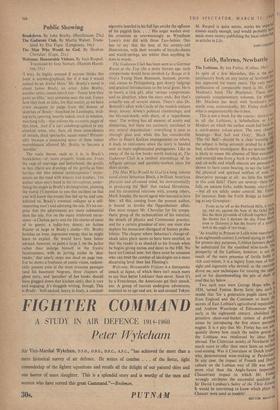Leith, Balerno, Newbattle
The Lothians. By Ian Finlay. (Collins, I8s.) curiously complementary volumes, for whereas satisfactory book on any sector of Scotland that has appeared for many years. The only recent publication of comparable merit is Mr. sterile area, economically, Mr. Finlay deals with Maclean's book The Highlands. These trial' IN spite of a few blemishes, this is the 005! • Mr. Maclean has dealt with Scotland's !O 4 what is unquestionably the richest.
This is not a book for the tourist : there is no'
in all the Lothians, a Schiehallion or L0,,el, Moidart on which the author could fall back 101 a catch-penny colour-piece. The very chapter' headings--'Red Soil and Grey'; 'Black -The Oil Belt'—should be a clear warning 111,3. the subject is being seriously probed by a quay fled, scholarly investigator. But no serious reader is likely to moan the absence of blue mountain', and emerald seas from a book in which coal-slag' and oil-wells and whegt sheaves are persuasively shown to have some bearing, to saY the least, 011 the physical and spiritual welfare of men. Nn descriptive passage at all : no little fire bursar'` in this cold field? There are several—their falls on ancient kirks, noble houses, objets ear' —but all are safely under control. Mr. FiulaY,' for instance, finds the Forth Bridge as fascinate ing as any Grampian:
From as far off as the Pentland Hills, it too'
up, end on, against the base of the Ochil 11111s' like the three pyramids of Ghizeh together. 1101,,: the HaWes Inn it darkens the sky. From 1-101'`7s • toun or Dalmeny it has the beauty of a vide' web in the angle of two twigs.
'As wealthy as Princes or Leith wine-merchants is an eighteenth-century Lowland saying in whicild' for present-day purposes, Lothian farmers shoni, be substituted for the vanished wine-lords. TO prosperity of the Lothians, however, is not the result of the mere presence of fertile fields (Ir rich coal-mines; it is a legacy from men of We• sight and ingenuity who devised, as the centurie' drove on, new techniques for treating the upPer soil or for disembowelling the pits of shale °( coal that lay below. Two such men were George Hope who, in 1830, turned Fenton Barns farm into such (1 model that 'for a generation pupils came 10 1 ,1, from England and the Continent to learn tn,' secrets of East Lothian's agricultural reputatio0' and Andrew Wauchope of Edmonstone w11°' early in the eighteenth century, abolished tile primitive chain-and-bucket system of draining t mines by introducing the first steam pumping engine. It is a pity that Mr. Finlay has not ad,`'' quately shown how much the native genius in the Lothians was reinforced by ideas fr°1'; abroad. The Cistercian monks of Newbattle 113" much more to offer than mere hints on surface coal-mining. Was it Cistercians or Dutch trader: who demonstrated wine-making at Parduvinc,' In any case, the impact of French and Dutch culture on the Lothian way of life was much more vital than the Anglo-Saxon (especially Chaucerian) impact to which Mr. Finlay wrongly attributes the successful qualities 0 Sir David Lyndsay's Satire of the Thrie Estails' It would be interesting to know which plays Chaucer were used as models!
HECTOR MaCIVF''










































 Previous page
Previous page